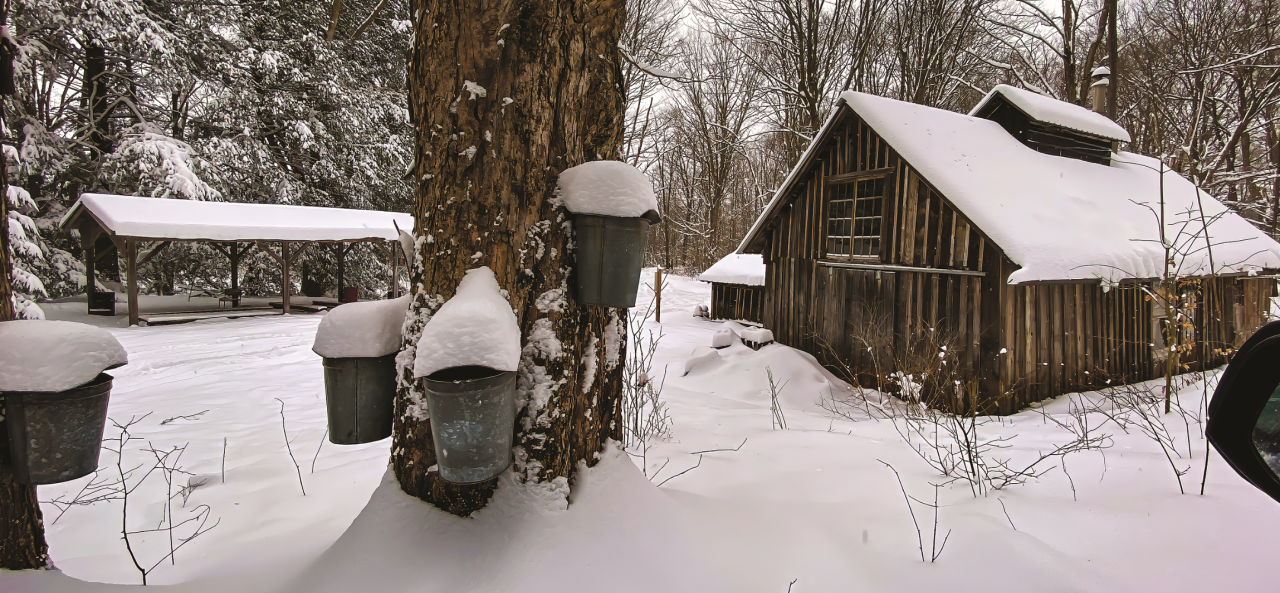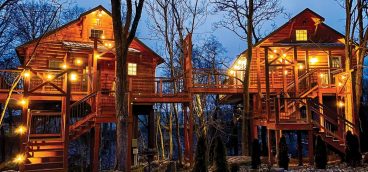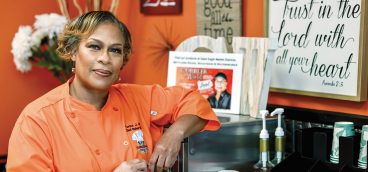It’s Tapping Time!

Most of us were taught that there were four seasons, but go to Hurry Hill Maple Farm Museum & Farm Stand in Edinboro, Pennsylvania, and you will learn about a fifth one. It’s sandwiched between winter and spring, during the time of mud and snow when the nights are still freezing and the days are above 40 degrees. That’s when the sap starts to flow in the sugar maple trees and “sugaring season” arrives. An age-old ritual of tapping into those majestic trees begins.
Retired high school principal Janet Woods is the museum’s founder and a lifelong maple syrup producer. She grew up on the former family dairy farm where she still lives. After winter, her family would tap the trees in their sugarbush (grove of mature maple trees), boil down the sap in an evaporator and sell the syrup for seed money for cabbage, an early spring crop.
After 23 years as an educator, Woods created a space that would not only promote maple syrup, but also teach young and old alike about everything from its history to its production and virtues. And she generously supports the industry and other producers in the region.
Woods has published a beautiful cookbook, Maple Syrup Recipes with tips and tales from Hurry Hill Maple Farm, that’s full of sweet and savory recipes, all of which incorporate maple syrup, as well as loads of information and anecdotes. It’s part cookbook, part maple bible — all that you will need to learn about maple syrup and how to use it. The book includes many of her blue-ribbon winning recipes from the Pennsylvania Farm Show, at which she has had a perennial interest.

Through the cookbook, Woods imparts background information about that bottle of maple syrup that you (hopefully) have stored in your refrigerator. Sugar maples grow natively only in North America, and regionally only in the Great Lakes areas of Canada and the U.S. Canada produces 90 percent of the world’s maple syrup and the U.S. the remaining 10 percent, with sap being collected during a less-than-eight-week period. A sugar maple tree must have a 12” caliper (diameter) and be approximately 30-40 years old before it is mature enough to be tapped, a process in which up to 2”-deep holes are drilled into it so that sap (sugar and water that is like the blood of the tree and meant to feed the buds in spring) can be drained and collected. It is then put in an evaporator where it is carefully boiled down — because, as Woods will stress, “When syrup boils, it boils over. Always!”
It takes 40 gallons of sap to make one gallon of syrup. Compared with other sweeteners such as honey, brown or white sugar, maple syrup is a nutritious rock star with much higher levels of minerals such as manganese, riboflavin, zinc, magnesium, calcium and potassium than its counterparts. It also comes in a variety of colors, which affect the intensity of flavor.

The museum is open on Sundays from mid-March through May, and then during September and October, as well as by appointment. It covers the history of maple sap collection and syrup use, from Native Americans to present day, with all sorts of artifacts, hands-on exhibits and displays for people of all ages. A small gift shop has all manner of maple products.
One room is dedicated to the book Miracles on Maple Hill by Virginia Sorensen. Sorenson, a Utah native, lived in Edinboro briefly and based her heartwarming book on real people and places there. In 1957, it beat out contender Old Yeller to receive the Newbery Medal, which is considered, along with the Caldecott Medal, the highest honor in children’s literature. There have been only 103 awarded, and if you are lucky, you may get to hold the actual medal, which is on permanent loan to the museum. Also on display are objects and original artwork from the book.

If all of this has you wanting to observe trees being tapped or maple sap boiling in a sugarhouse, then be sure to attend the 21st Maple Taste and Tour Weekend, March 16 and 17. Sponsored by the Northwest Pennsylvania Maple Syrup Producers Association, this annual event includes 19 sugarhouses from a six-county region. You can visit both large and small producers — many are multi-generational — with antique and wood-fired evaporators as well as modern equipment. Free samples abound, with tours, demonstrations, wagon rides and lots of maple-centric foods available for purchase. You can get your fill of maple bacon, maple hot dogs, maple candy, maple latte, maple mustard and, of course, bottles of pure maple syrup. Festivities include raffles and entertainment so put on some boots, dress for the weather and prepare to be amazed.
Woods is donating all of the money from Hurry Hill Farm’s donations jar on the tasting table from the weekend to the Lahaina, Hawaii Bookmobile to aid recovery from devastating fires last summer.
For more information about Hurry Hill Farm, or to order a cookbook, go to their Facebook page or website, where there are many links and virtual tours: hurryhillfarm.org.
Information on the Taste and Tour weekend can be found at: pamaple.org/taste-tours













